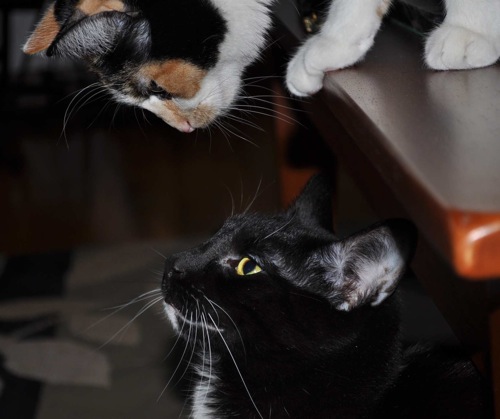New pets should always be carefully introduced to your cat to prevent conflicts. Here are established guidelines you can follow for successful introductions.
Introducing New Pets
New pets must be properly introduced to your cat. That means that introductions should be done slowly and with care to avoid creating hostility between animals. Animals should never be thrown together and left alone to "work things out". There are established guidelines to follow for successful introductions.
Introducing a New Cat
Introducing a New Cat The new cat should be given her own room containing the necessities; food, water, a litter box, a scratching post, perch, and toys. This is just like a except that the new cat is not permitted to leave that room, yet. The newcomer should be kept in her room for at least one week. The cats need time to get familiar by smelling one another without coming face to face. Although your cat will smell the new cat's scent on you, you may better acquaint the cats with one another's scent by giving each a towel to lay on and then swapping the towels after a couple of days.
When the cats have gotten familiar with one anothers scent, begin feeding them on opposite sides of the closed door. This creates a positive association between food and the other cat's scent. When the cats are eating comfortably at the door you can start introducing visual contact.
Allow gradual visual contact by opening the door a crack. Secure the door so the cats may look at one another but not walk through. It is common for cats to hiss at each other initially but if they become aggressive or extremely hostile close the door and leave them alone for a few hours. Crack the door open again when the cats are relaxed.
When they can look at one another calmly, open the door wider. After the cats can look at each other without hissing or becoming agitated, open the door and let them meet while you watch from a distance. If problems occur, return the new cat to her room and close the door. Gradually increase open door time until the cats are comfortable with each other. Keep the room available to the new cat so she has a safe place to retreat to if she feels threatened.
Introducing a New Dog
Before bringing your new dog home, make sure your cat has a refuge. When you bring the dog home do not let him have full access to the house. Confine him to one or two rooms using baby gates. Let your cat investigate this newcomer at her own pace. Keep the dog confined until the cat is comfortable moving around the house and approaching the baby gate to investigate.
Next, set up some controlled meetings. Put the dog on lead and walk him into the room where the cat is sitting. Walk him around the room on a loose lead (a tight lead will transmit your anxiety about the situation to the dog). Do not allow the dog to act inappropriately toward the cat (barking, lunging, chasing). A mild correction ("no") and a request to "sit" should suffice. If the correction is too severe the dog will associate getting into trouble with the cat. Reward calm behavior from the dog using praise and food treats. Give special treats and praise to the cat when the dog is in the room to help create a positive association with the presence of the dog.
The cat may hiss, swat, and growl at the dog. Do not punish her for this or she will associate the dog with the punishment. Repeat these controlled meetings until both animals remain calm and relaxed with each other. Don't allow the dog to have free run of the house until you are certain the animals are comfortable with one another.
Most dogs and cats can live together peacefully. It is important to remember that dogs are natural predators of cats. For this reason you should never permit the dog to chase the cat or pick her up in his mouth. You may know that the dog has friendly intentions but the cat doesn't!


